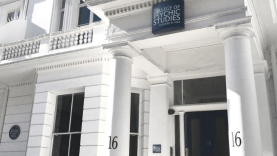
The College of Psychic Studies is a spiritualist organization based in London, offering mediumship training and educational courses related to consciousness, healing and the psychic arts.
History
The College of Psychic Studies traces its origins to the foundation in 1874 of the British National Association of Spiritualists (BNAS), based in London at 38 Great Russell Street.1 In 1882, the BNAS changed its name to the Central Association of Spiritualists (CAS), before breaking up as a result of internal conflicts and financial problems.2 It was replaced by the London Spiritualist Alliance (LSA), founded by William Stainton Moses, an Anglican priest who had developed mediumship abilities. The LSA was also based in London and began its activities early in 1884. Its magazine Light, which had first appeared as a weekly on 8 January 1881, was edited by Edmund Rogers, attracting literary figures on its editorial board including Constance Sitwell, Rosamond Lehmann and Kathleen Raine.
The LSA eventually acquired premises at 16 Queensberry Place, South Kensington, London in 1925,3 when Arthur Conan Doyle became its president. From 1926 to 1930, the top floor was leased to the psychic investigator Harry Price for his National Laboratory of Psychical Research. The rooms were converted into six laboratory areas with apparatus and recording equipment aimed at studying psychic phenomena and the abilities of mediums and psychics,4 some of whom, like Helen Duncan, were found to be fakers.5 In 1955 the LSA changed its name to the College of Psychic Science and in 1970 it became the College of Psychic Studies (CPS).
Library and Archive
The LSA built up a large collection of specialist esoteric books, now numbering more than eleven thousand, along with letters, notebooks, pamphlets, periodicals and spirit photographs. Its archive also contains artefacts such as ouija boards, spirit trumpets, planchettes and crystal balls that were used in séances.
Notable among its activities was mediumistic and psychic art that began in the UK in 1856 with Anna Howitt Watts and Georgiana Houghton, both founder members of the CAS in 1884.6
Activities
The subjects explored at the college have diversified in recent times to include workshops and talks in mediumship training, trance, psychic development, working with guides and angels, automatic writing, past and future lives, shamanic healing, chakras, energy work, palmistry, numerology, tarot, mysticism, paganism, scrying and crystals. One-to-one healing sessions and psychic mediumship readings are also offered.
Books
In 1930, the London Spiritualist Alliance (as LSA. Publications Ltd) published five books.
Dallas, H.A. (1930). Human Survival and its Implications.
Drayton Thomas, C. (1930). The Mental Phenomena of Spiritualism.
De Brath, S. (1930). The Physical Phenomena of Spiritualism.
MacGregor, H., & Underhill, M.G. (1930). The Psychic Faculties and Their Development.
Lodge, O. (1930). Demonstrated Survival: Its Influence on Science, Philosophy and Religion.
Presidents
College presidents have included many names of note in psychical research, including:
William Stainton Moses 1884-1892
Edmund Dawson Rogers 1892-1910
Sir Arthur Conan Doyle 1926-1930
Arthur J Findlay 1934-1934
Constance Sitwell 1943-1947
Brigadier R C Firebrace 1952-1966
Paul Beard 1966-1982
Brenda Marshall 1982-1992
Dudley Poplak 1992-1995
Geoffrey Dart 2017-present (2023)
Website
https://www.collegeofpsychicstudies.co.uk/
Melvyn Willin
Literature
Oppenheim, J. (1985). The Other World: Spiritualism and Psychical Research in England, 1850-1914. Cambridge, UK: Cambridge University Press.
Price, H. (1933). Leaves from a Psychist’s Case-book. London: Victor Gollancz Ltd.
Endnotes
- 1. Oppenheim (1985), 53-57.
- 2. Oppenheim (1985), 53-57.
- 3. https://www.collegeofpsychicstudies.co.uk/
- 4. https://www.collegeofpsychicstudies.co.uk/
- 5. Price (1933).
- 6. https://www.collegeofpsychicstudies.co.uk/

